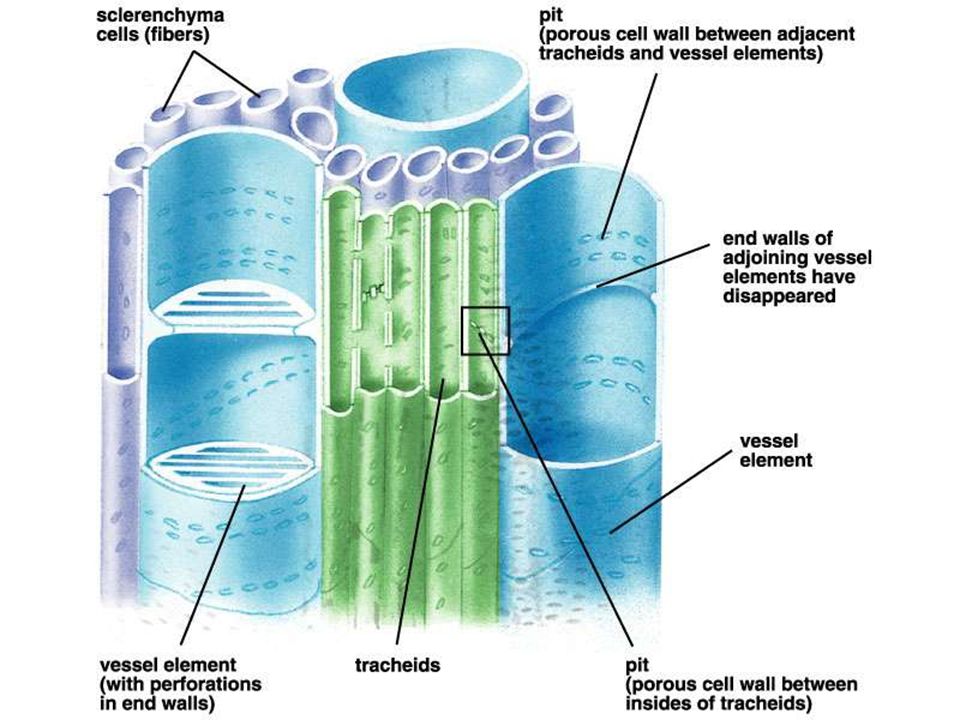
- A group of more than one type of cells having common origin and performing different but closely related functions as a unit is called complex permanent tissues.
- The cells may be living or dead.
- The important permanent tissues in vascular plants are: Xylem and Phloem
- Both of these tissues are commonly known as vascular tissues as they are conductive in function.
1. Xylem:
- It is the chief conducting tissue of vascular plants responsible for conduction of water and inorganic solutes.
- It consists of four components; tracheids, vessels (tracheae), xylem fibers (wood fibers) and xylem parenchyma.
a. Tracheids:
- They are elongated tube-like dead cells (without protoplasm) having tapering ends.
- The walls are hard and lignified but not much thick and enclose a wide empty lumen.
- In the beginning, these cells possess living protoplasm but due to lignification and deposition of thickening materials in wall, they become dead at maturity.
- Tracheids possess various types of wall thickenings; annular (ring like), spiral (helical), scalariform (ladder like), reticulate (network) and pitted. The pits may be simple or bordered.
- The end walls are perforated by the presence of bordered pits which permit flow of water from one cell to another.
Functions:
- They conduct water and dissolved mineral elements from roots to the leaves.
- They also provide mechanical support due to the presence of hard and firm secondary walls.
b. Vessels or tracheae:
- They are long tubes consisting of a series of drum-shaped cells placed one above the other with their walls perforated or dissolved.
- Vessels are syncytes formed by the fusion of cells.
- Each cell appears circular, oval or sometimes polygonal with a very wide lumen which later becomes lignified and dead.
- Vessels like tracheids possess various types of thickenings like scalariform, reticulate and
Functions:
- They are the chief conducting tissues of vascular plants, particularly in angiosperms. They translocate water and minerals from roots to the leaves.
- They also provide mechanical support to the plants.
c. Xylem fibers or wood fibers:
- The xylem fibers develop from the same meristematic tissues as the other xylem cells.
- They have lignified secondary walls and narrow cell lumen.
- They are usually longer than the tracheids of the same plant and present both in primary as well as secondary xylem.
Functions:
- It conducts water and minerals from root to leaves and also provides mechanical support to the plant.
d. Xylem parenchyma:
- These are living parenchymatous cells present as component of the xylem, both in primary and secondary xylem.
- Wood parenchyma and ray parenchyma are two types of parenchyma present in secondary xylem.
- The wood parenchyma is formed from fusiform cambium initials whereas ray parenchyma is formed from ray initials of the cambium.
- Both of them have thin walls and living protoplasm.
Functions:
- Their main function is storage of food in the form of starch or fats.
- They also help in conduction of water and minerals.

2. Phloem:
- It is the chief food-conducting tissue of vascular plants responsible for translocation of organic solutes.
- The phloem is composed of four components; sieve elements, companion cells, phloem parenchyma and phloem fibers.
- A fifth kind of cell type, the transfer cell has recently been reported from the phloem.
a. Sieve elements:
- These are the main components of the phloem which are placed one above the other forming sieve tubes.
- They are long tubular structures which consist of living cells without nucleus, endoplasmic reticulum, mitochondria, plastids etc.
- Cytoplasm occurs in the form of thin lining enclosing a big central vacuole which is filled with albuminous substance.
- There is presence of sieve areas (group of pores present in walls) and sieve plates (the portion of cross wall with sieve areas) in sieve elements.
- The sieve plates may be simple or compound.
- The sieve tubes are syncytes (formed by fusion of cells) and allow free diffusion of organic substances.
Functions:
- They help in translocation of organic solutes (prepared food) from leaves to different body parts.
b. Companion cells:
- These are living cells, each cell always associated with one sieve tube or sometimes more.
- The cell consists of thin cellulose cell wall and active protoplast with all important cellular components; nucleus, plastid, endoplasmic reticulum, ribosomes etc.
- The common wall between companion cell and sieve tube shows presence of fine pits which are traversed by plasmodesmata.
- They are present in angiosperms (both monocots and dicots) but are absent in pteridophytes and gymnosperms.
Functions:
- They assist the sieve tubes in the process of translocation of solutes.
c. Phloem parenchyma:
- They are living parenchymatous cells which are elongated with rounded ends and primary cellulose cell walls.
- They are present in most of the dicots and absent in monocots.
- Phloem ray cells are present in secondary phloem which become lignified as soon as the sieve tubes cease to function.
Functions:
- The cells store food in the form of starch and fats. Sometimes they contain resins and tannins.
- They also help in the translocation of organic solutes.
d. Phloem fibers:
- They are non-living cells also called bast fibers and mostly occur in secondary phloem.
- These fibers have both cellulose and lignified thickenings.
- Secondary phloem consists of elongated lignified cells with simple pits.
- The ends of these cells may be pointed needle-like or blunt.
Functions:
- They provide mechanical support and give strength and rigidity to the plant parts.
